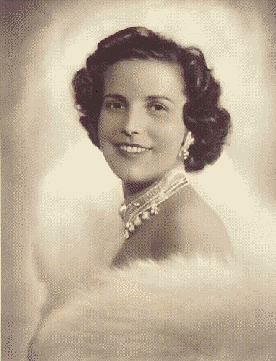by Scott Mehl © Unofficial Royalty 2015

Princess Lilian of Belgium, Princess de Réthy; Photo: Wikipedia
Princess Lilian of Belgium, Princess de Réthy, was the second wife of King Leopold III of Belgium. She was born Mary Lilian Baels on November 28, 1916, in Highbury, London, England. Lilian was one of eight children of Henri Baels and Anne Marie de Visscher. Henri Baels was a shipowner from Belgium and later rose in the ranks of government, becoming Governor of West Flanders in 1936. He was also a close friend of Albert I, King of the Belgians, and later an advisor to King Leopold III.
Lilian began her studies in London, England and then attended the College of the Sacred Heart in Ostend, following her family’s return to Belgium. She later studied French in Brussels and attended a finishing school in London. In the late 1930s, Lilian encountered her future husband several times, often accompanying her father to official events. She was often invited by Leopold’s mother, Dowager Queen Elisabeth, who saw an opportunity to bring the couple together. Following several visits to Laeken, where King Leopold III was under house arrest by the Nazis, Leopold proposed in July 1941. Lilian accepted but declined the title of Queen. Instead, Leopold gave her the title ‘Princess de Réthy’, and it was decided that any children would not have succession rights. They would, however, be styled and titled HRH Prince/Princess of Belgium.
Lilian and Leopold married in a religious ceremony held in the chapel at the Palace of Laeken in Laeken, Brussels, Belgium, on September 11, 1941. This was against Belgian law, which required a civil ceremony to be held first. They had planned to wait until after the war to hold a civil ceremony, but Lilian’s pregnancy led them to hold the civil ceremony on December 6, 1941, at which point their marriage was made public. The announcement was met with mixed reactions from the Belgian people. While some sent congratulations, many others felt that the marriage sullied the memory of Leopold’s first wife, their beloved Queen Astrid, who died in a car accident, and that Lilian was nothing more than a “social climber.” Despite this, the couple had a very close and happy marriage. Lilian also had a close relationship with Leopold’s three children, Josephine-Charlotte, Baudouin, and Albert.
Leopold and Lilian had three children who were Prince/Princess of Belgium, but did not have any rights of succession:
- Prince Alexandre (1942 – 2009), married Léa Inga Dora Wolman, no children
- Princess Marie-Christine (born 1951), married (1) Paul Drucker, no children, divorced (2) Jean-Paul Gourgues, no children
- Princess Marie-Esméralda (born 1956), married Sir Salvador Moncada, had two children
In 1944, King Leopold and his family were deported to Germany and then Austria before being freed by US forces in 1945. However, due to questions about Leopold’s actions during the war, they were unable to return to Belgium and settled in Switzerland. Finally, in 1950, they returned, but King Leopold’s reign was short-lived. He quickly transferred most of his duties to his eldest son, and in July 1951, formally abdicated in his favor.
Leopold, Lilian, and their children remained at the Palace of Laeken until 1960, when King Baudouin married. Having been pressured to move elsewhere by the government, which felt that King Leopold was exerting too much influence on his son, and with Baudouin now married, the couple moved to the estate of Argenteuil in Belgium, a government-owned property.
Over the years, Lilian’s relationships with her stepchildren deteriorated to a certain degree, specifically around the time of their marriages. When Josephine-Charlotte married Hereditary Grand Duke Jean of Luxembourg, Lilian caused a stir by insisting, unsuccessfully, that she should take precedence over her mother-in-law, Dowager Queen Elisabeth. This caused the bride much stress and caused a rift between the two for the rest of their lives. When Baudouin married in 1960, his new wife, Queen Fabiola, clashed with Lilian in taking her rightful place as First Lady of Belgium. This relationship deteriorated to the point that they were only seen together publicly on one occasion, the funeral of Queen Elisabeth in 1965.
However, Lilian did maintain a closer relationship with Albert and his wife, Queen Paola. This was tested when she sold off some of the jewelry she’d been given by King Leopold, following his death in 1983. Most notable was the Cartier tiara originally owned by her mother-in-law, Queen Elisabeth. She sold the tiara back to Cartier in 1987. In her defense, however, it should be noted that these were not jewels owned by the family or a family foundation like many other royal houses have. Belgium does not have anything like that established, meaning that most of the jewelry is privately owned and, sadly, often leaves the family through marriages or auctions. Despite this, Albert remained close to his stepmother for the remainder of her life.
Despite surviving her husband by nearly 20 years, it was at his funeral that Princess Lilian made her last official public appearance. She spent the remaining years of her life pursuing her interests in medicine, having established a Cardiology Foundation in 1958 following her son Alexandre’s heart surgery the previous year in the United States and editing her husband’s memoirs “Pour l’Histoire” (For History), published in 2001.
Princess Lilian remained at Argenteuil, where she died on June 7, 2002. Her funeral was held at the Church of Our Lady of Laeken in Brussels, Belgium, attended by all of the Belgian royal family except for her elder daughter, Marie-Christine, who completely severed all ties with her family. Princess Lilian was interred in the Royal Crypt at the Church of Our Lady of Laeken, beside her husband and his first wife, Queen Astrid.
This article is the intellectual property of Unofficial Royalty and is NOT TO BE COPIED, EDITED, OR POSTED IN ANY FORM ON ANOTHER WEBSITE under any circumstances. It is permissible to use a link that directs to Unofficial Royalty.
